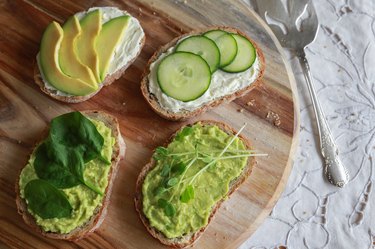
Candida, or candidiasis, is the overgrowth of naturally occurring yeast called candida albicans. Candida albicans flourishes in body places that are moist and warm, such as your mouth, genitourinary tract and stomach. When fighting a candida overgrowth, it is important not to contribute to the problem by feeding it more yeast, such as in bread. Sourdough bread, if made the old-fashioned way, has no yeast.
Symptoms of Candida
Video of the Day
Candida usually starts in the gut and causes damage to the intestinal wall, according to the National Candida Society. This condition is called "leaky gut syndrome" and may give rise to allergies, depression, migraines and foggy brain. You may also experience constipation or diarrhea, flatulence, bloating, itchy anus, sinusitis, weight gain or loss, joint pain, muscle fatigue, PMS, menstrual irregularities, cystitis, thrush, athlete's feet and fungal infections of your nails.
Video of the Day
Diet for Treating Candida
Treating candida can be a long process that incorporates anti-yeast medications, supplements and diet. A candida diet aims to re-establish the natural flora of the gut by killing back, or starving, the yeast. A diet suggested by the Henry Spinks Foundation consists of increasing green, leafy vegetables and avoiding or limiting processed foods, such as starch and sugars, and foods that include fungi, molds and yeast, such as breads.
Sourdough Bread
Sourdough bread from your grocery store does not ensure you are purchasing bread that is low in yeast, as many commercial sourdough bread recipes use yeast. Sourdough bread is made in two parts -- the sourdough starter, or starter, and the main recipe. A starter encourages naturally occurring yeast that is on every living thing, including flour, to grow and make the bread rise. This keeps the yeast content low and aids in starving the candida.
Old-Fashioned Sourdough Starter Recipe
This recipe is adapted from an American colonial sourdough starter that comes from Education.com. You first need to make the starter in a large bowl by mixing 1 cup of warm water to 1 cup of flour and 1 tbsp. of white sugar. Cover the starter with a tea towel and let sit at room temperature, adding 1/2 cup of warm water, 1/2 cup of flour and 1 1/2 tsp. of sugar each day for 5 days. Afterwards, the starter may be kept refrigerated for future use as long as it is fed every 3 or 4 days. If you find you have too much starter, give some to friends or throw some away.
Berkeley Sourdough Bread Recipe
This sourdough bread recipe is adapted from the Science of Cooking website. For the sourdough bread, in a mixing bowl with a dough hook, add 2 1/2 cups of unbleached white flour, 1 ½ tsp. of salt, ¾ cup of starter and ¾ cup of water at room temperature. Mix with dough hook until dough ball comes away from the side of the bowl. Put the dough ball in a well-oiled bowl, cover and let rise in the refrigerator about 12 hours or overnight. Shape the dough into a shape of your choice and let rise again, covered, on a floured surface, at room temperature for about six hours. Bake at 475 degrees Fahrenheit for 25 to 30 minutes.